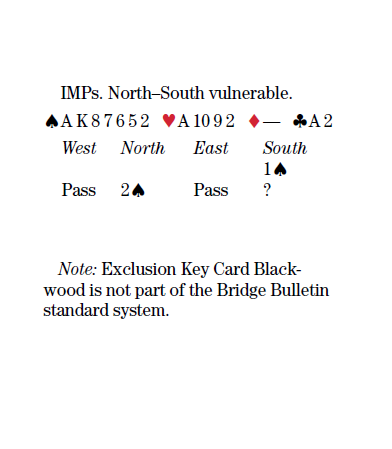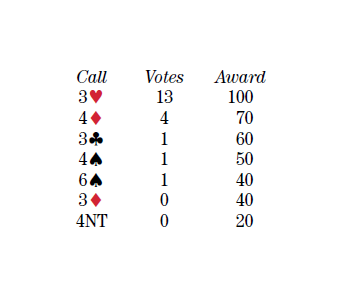
What’s your call?
| 2NT | ||||
| 3♣ | 3♦ | 3♥ | 3♠ | 3NT |
| 4♣ | 4♦ | 4♥ | 4♠ | 4NT |
| 5♣ | 5♦ | 5♥ | 5♠ | 5NT |
| 6♣ | 6♦ | 6♥ | 6♠ | 6NT |
| 7♣ | 7♦ | 7♥ | 7♠ | 7NT |
| Dbl | Pass |
In the slam zone
Thirteen panelists believe 3♥ is their lucky call.
“Because a grand is cold opposite the right 6 count (even a perfect 3 might do), it is right to look,” says Falk. “I will start with 3♥, and follow up accordingly. If partner returns to 3♠, I will bid 4♣. A 4♦ splinter could be right, too. With this heart holding, though, I like emphasizing interest in partner’s heart holding.”
Robinson also starts with 3♥, planning to bid 4♣ over 3♠. “Hopefully this will show short diamonds and partner can evaluate. I don’t want to be in slam opposite ♦K Q x.”
Boehm, too. “First, bid where I need help. Next, control cuebid.”
“3♥,” offers Meyers, “and if partner bids 4♠, I will bid again.”
“If I hear 4♥ from partner, I will cuebid 5♣,” suggests Kennedy. “A diamond splinter bid would not bring needed information from partner.”
“If partner likes my 3♥ game try and cooperates, I will move toward slam,” says Hampson. “If partner rejects my try, I will settle for game in spades.”
“We will be groping,” the Gordons say, “but 3♥ is a good place to start.”
If partner raises 3♥ to 4♥ or bids 4♠, the Joyces’ plan is to bid 6♠ directly.
“I hope 4♦ is a splinter.” says Weinstein. (It is.) “I have very good prospects for slam and showing short diamonds is the best way to get partner involved in the decision process. I’m planning on following with 5♦ over 4♠, or 5♣ over 4♥ to find out about partner’s round-suit help.”
Meckstroth starts what is undeniably a slam search with 4♦. “Hopefully partner can bid 4♥. I think I’ll come again with 5♣ over 4♠.”
Walker’s plan is the same: 4♦, showing shortness. “Then 5♣ if partner rebids 4♠. Pinpointing what I don’t need seems the best way to get partner to focus on cards in the other suits. Other advances (3♥, then 5♣ or 5♦) will make it sound like I need a control in the unbid suit.”
Sanborn bids 4♦: “A slam try with short diamonds (likely a void). This bid helps partner evaluate cards in the red suits. How would he like:
♠x x x ♥K Q x ♦x x x x x ♣K x?
This hand becomes a slam drive facing my splinter.”
Cohen starts with 3♣. “I want to see if partner bids (or doesn’t bid) 3♦. If he shows diamond cards, I will content myself with 4♠. If he does something else, like bid hearts, I’ll think about slam. Blasting into 6♠ might attract votes, but opposite only three (likely) trumps and possible wastage, it is too much of a shot to take.”
Colchamiro blasts into 6♠. “I’m torn between 6♠ and a 4♦ splinter,” he explains. “Even if I try 3♥ or 4♦, there are so many hands where partner, holding ♥x x or ♥Q x, would not show enthusiasm. I’d rather blast and conceal than be scientific.”

